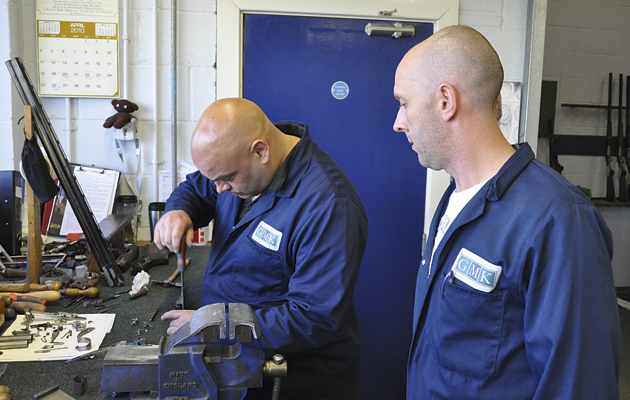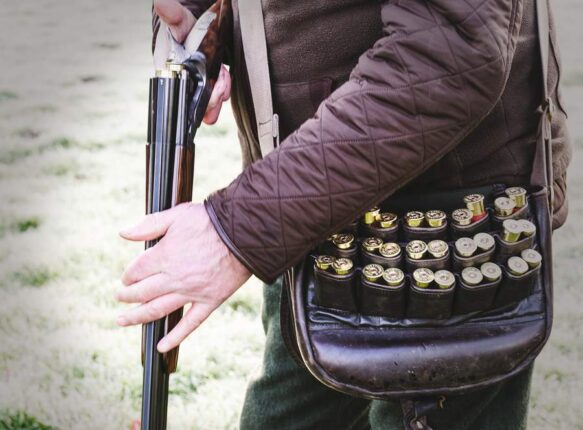Shotgun servicing costs little compared to the loss of a day's shooting. We tell you when and where to have your gun serviced.
Shotgun servicing is an essential part of one’s yearly sporting routine, whether you own a useful workhorse or one of the 10 most expensive guns in the world. Shotguns are among the most reliable machines and can last for centuries in good working condition if treated with a modicum of respect. However, to ensure longevity and avoid malfunction in the field, shotguns need regular cleaning and servicing, known in the trade as a “strip and clean”.
Shotgun servicing, cleaning and care
Basic care and cleaning are no more than common sense when it comes to shotgun servicing. The bores must be attended to after every outing and left mirror-bright, and all external surfaces must also be free of dirt, damp and residue. If the gun’s wet, it must be left to dry slowly, away from direct heat. Be especially careful to avoid condensation when you bring it in from the cold or when it has been removed from an aircraft hold. If multi-chokes are fitted, remove them periodically, scrub them and lightly lubricate the tubes and threads (oil should be used sparingly).
Firearms are often damaged by over-cleaning, particularly through disassembly by those who do not have the requisite skills or tools. Never attempt to remove a lock plate unless you have a precisely fitting turnscrew (if in doubt leave it to a gunsmith). Sometimes, after a dry day’s shooting, I will just push some scrunched up loo paper through the bores with a rod (three sheets fit a 12-bore nicely) and wipe off the action face and knuckle with the same wonderfully serviceable material. If you use this method, you must take scrupulous care that none of the paper is left in the barrels. (Read: why you should clean your gun regularly.)

Basic gun care is no more than common sense.
Shotgun changes to watch for
Loose barrels
It pays to look out for subtle changes in guns. If the barrels become loose – what is known as “off the face” – attention is required. You can check for this by removing the fore-end and simply rattling the gun. A cure may be effected by clever modern welding techniques on the bearing surfaces, putting in a replacement cross pin or fitting new studs if the gun has bifurcated lumps and trunnion hinging. A gun that is off the face will appear to recoil noticeably more and must be fixed promptly to prevent further damage. Similarly, if the butt or fore-end becomes loose, remedial action should be taken without delay. If you do not attend to the problem, you may end up with a broken stock or fore-end, which will be expensive to replace. Restocking a sidelock gun is not going to leave you much change out of £5,000 these days (double that or more if the work is done by a London maker), so it pays to keep a watchful eye.
Dented barrels
Another potentially expensive problem – and a common one with English guns – is dented barrels. It is usually easily cured at an early stage. If left, though, a dent may develop into a ring bulge or become a thin spot, which can lead to serious costs. Good-quality replacement barrels on a best gun will not cost much less than £7,000 if chopper lump and may cost as much as £20,000 if supplied by the gun’s original maker. I periodically check my guns by the simple expedient of looking at and through the barrels very carefully and running the exterior surfaces between my fingertips. You will be surprised how easily tiny imperfections will be revealed by the pads of your forefinger and thumb. Dents can simply be popped out with a hydraulic tool but they can destroy a gun if left unattended.
Barrel ribs
It’s also important to ensure the barrel ribs have not come loose. If they have, water may seep in under the rib and cause hidden damage – a common problem on older guns. You can check for loose ribs on a side-by-side (where the problem is more likely to occur) by the following method: disassemble the gun, and, taking great care, suspend the barrels by the front lump with a finger. Now tap their sides with a pencil. If they ring true, nothing is amiss, but if you hear a tinny rattle it is likely that the ribs have lifted. They will have to be removed and the barrels and ribs will need to be relaid and resoldered. Following that, the barrels will also require re-blacking and, possibly, re-regulating.
Ejectors, triggers and safety mechanisms
Other things to watch out for include ejectors that are poorly timed (check they’re working simultaneously with a pair of snap caps); weak strike on primers (possibly caused by tired mainsprings or worn firing pins); and a top lever that feels spongy or comes back beyond the central position. It is also important that the triggers and safety mechanism operate reliably and crisply. Occasionally, cracks develop in actions, more frequently in ejector limbs, and sometimes lumps and loops become detached from the barrels.
Servicing by a gunsmith
Many believe, rightly, that several of the problems mentioned warrant shotgun servicing by a skilled gunsmith. How often varies according to use. A “fair-weather” shooter should opt for a strip and clean every 18 months to two years. If the gun’s used often in rain, the frequency of servicing might increase to once a season. And if it suffers a severe soaking, such as being immersed in saltwater when wildfowling, then it should be taken to a gunsmith immediately. (Read Michael Yardley’s list of the top 10 gunsmiths.)
A normal shotgun service would including stripping the action and ejector mechanism completely, checking for wear, repairing as necessary, oiling and reassembly. The barrels and chambers are often polished and lead and plastic residue removed from the bores.
The most common problems with side-by-sides are the strikers (firing pins), which are often replaced. Ejectors mistiming create another common problem, as do top lever springs, which may suddenly break or become spongy over time, and weak mainsprings.
Typical problems with modern over-and-unders are not dissimilar. Chipped or dented firing pins are common with some makes, as are weak mainsprings; the latter tend to be cheaper and easier to replace than those in a side-by-side because they are usually helical rather than handmade V-springs.

A Beretta doesn’t necessarily need an annual service, but take it to GMK if it does.
Malcolm Grendon, a traditionally trained gunsmith, is head of the highly efficient, modern workshop at GMK, the Beretta importer. “We advise clients,” he told me, “to have the actions of their guns stripped and cleaned periodically depending on use. It would be wrong to say everyone needs an annual service for a Beretta. What is a real red flag, though, is when a gun becomes loose on the face of the action or one notes a top lever coming back beyond the central position. Then, immediate attention is required, as is any case of trigger or safety malfunction.”
Although Berettas are tough and reliable, they have the advantage of main bearing parts being available in various oversizes should they be required. There are, for example, three sizes of hinge-pin – GMK calls them discs – for the whole range (with the exception of the SO sidelocks, which require a custom-fitted disc should replacement become necessary). The conical locking bolts of the boxlock over-and-unders are also available in two sizes (plus 15 thou and plus 30 thou). The hinge-pins and bolts require fitting by a skilled operative (but they don’t always have to be replaced together); sears and internal springs do. Ejector springs are interchangeable.
More on Berettas
Berettas, like most modern over-and-unders, have brazed ribs rather than the soft-soldered variety used in English barrels, so experience few problems with loose ribs. However, because they are vented, it is easier for the top rib to be dented, something that can be rectified fairly easily with a special tool. Grendon observes that cosmetic issues are often part of a thorough service: “We polish barrels flats and ejectors routinely and the monobloc flats can also be re-jewelled if required.” Beretta firing pins rarely break but, ”We do occasionally see cracks in stocks and fore-ends and these may be repaired or re-placed.“ Grendon makes the point that poor disassembly may cause unnecessary problems. Fore-ends are sometimes wrenched down carelessly over the front of the ejector work, damaging the wood. The correct pro-cedure is to pull the fore-end latch down, bring the fore-end a few millimetres off the barrels and slightly forward, then remove it.
Grendon notes the dangers of over-oiling and stresses the importance of using the correct lubricants. Traditional grease attracts grit, so his advice is to use a synthetic oil on the action knuckle and keep it lightly lubricated. Beretta barrels do not need routine oiling as they are hard-chrome-lined (as are Beretta chambers). He recommends keeping multi-chokes clean and lightly lubricated on the threads and stresses the importance of checking that they are securely tightened.
What about servicing a London gun?

The experts are often best at disassembling a gun.
What should you do if you own a London gun? Andrew Ambrose, formerly gunroom manager at Holland & Holland, says, “We suggest to our customers who shoot regularly that an annual service makes sense and is a cost-effective way of keeping a capital gun in good condition. Obviously, if a gun has not been used, it may not need servicing as frequently, with the caveat that sometimes storage of itself can create issues such as oil seeping into wood (which is why many store their guns muzzle-down in cabinets), and rusting, which is a particular problem if it is affects the joints between barrels and ribs.”
Ambrose continues, “Generally, our standard service is particularly comprehensive and would involve the action not only being completely disassembled but also being removed from the butt. Similarly, the fore-end iron and the components therein would be taken off the wood. We take every metal part and boil and then clean them by hand. They are dried off, lubricated and checked for wear before re-assembly. Often a part that is likely to fail may be spotted and pre-emptive action taken. That said, one cannot always predict when a mainspring might fail. Our service takes four-and-a-half hours and if no new parts are fitted this would cost £325 excluding VAT.” Rust re-moval would add to the cost.
If you are not quite sure when your gun was last serviced, compare the cost of having it done with the disappointment and expense of losing a day’s shooting due to gun malfunction. And if you decide a service is in order, it’s best that you arrange for it to be done now, before next season is upon us.
This article was originally published in 2015 and has been updated.





